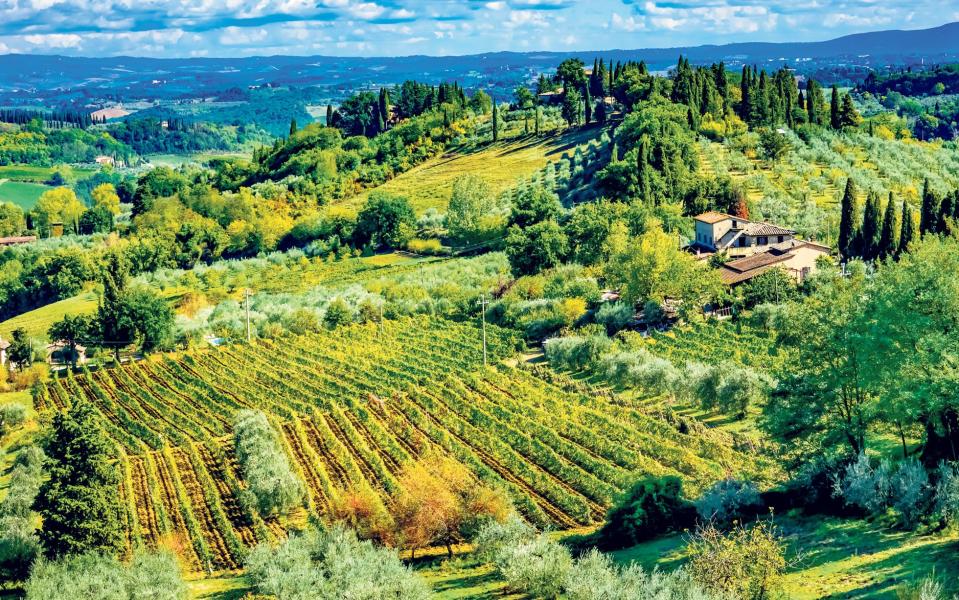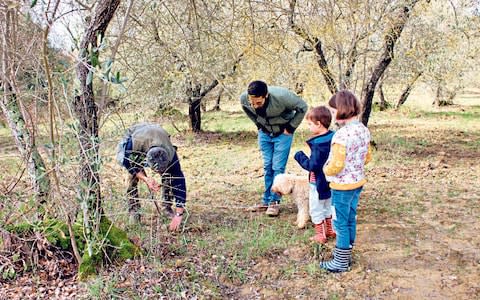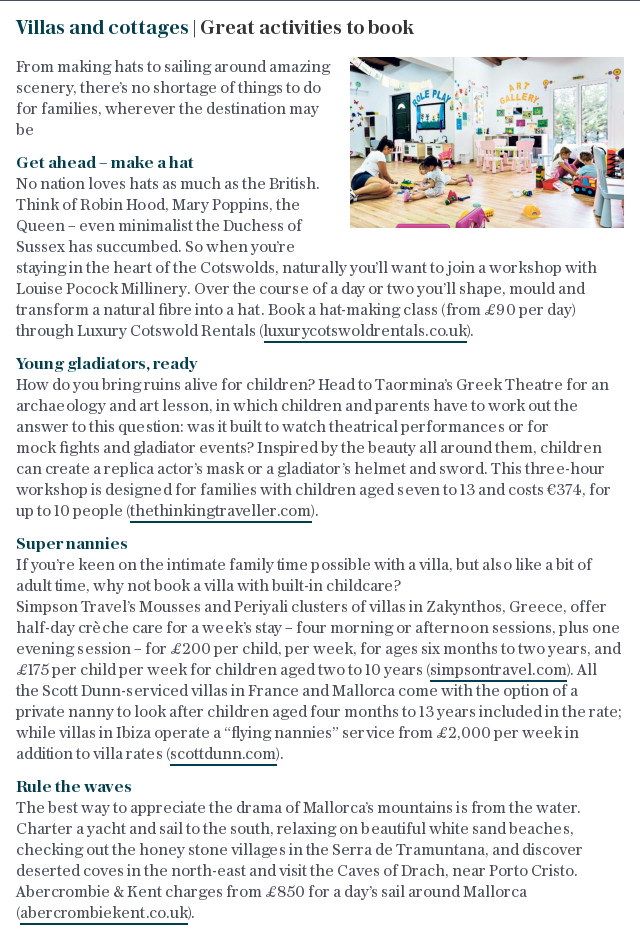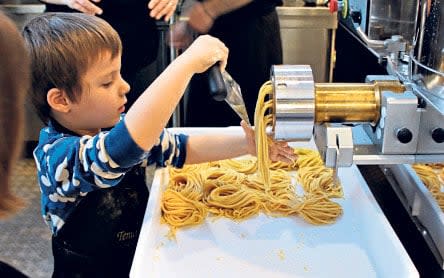The holiday villas changing the way we travel

It was a misty Thursday morning, with the low Tuscan hills’ muted tones in the distance, when we set out with a six-year-old Lagotto Romagnolo in pursuit of something my children both love and hate.
Truffles – the fungus, not the chocolates – are catnip in my house when they come in the form of musky oil on crisps (£3.95 at our local deli). On pasta, they’re less well received. But Antonia (six) and Henry (four) were suitably impressed with the set-up: a hipster and a farmer in pursuit of a high-value product; if there was a scent of earthy delights, there was also more than a whiff of a Famous Five mission.
We followed Paulo, president of the local truffle-hunting association, who was dressed in camouflage and accompanied by his dog, Millie, past a cemetery and into the hills, where we met our translator, Lorenzo, the landowner, who had abandoned a tech-focused life in cosmopolitan Siena to get back to nature (well, the sort of nature where one wears skinny jeans and Ray-Bans) with his family.
Millie had been in training from the age of two months: Paulo hid morsels of truffles under the ground or in the grass, making a game of chasing down this fragrant harvest.
While Henry spent most of his time hunting porcupine quills in the grass, Antonia was impressed with the science behind the cultivation (“Just as an apple is at the end of a tree’s branches, a truffle is at the end of its roots,” Paulo said, explaining the symbiotic relationship). She was also on board with the economic element of our chase: while we were in pursuit of the relatively low-value tartufo marzuolo, a white-ish variety that is found in springtime, Paulo regaled Antonia with tales of the prized white truffles that develop in the autumn – he’d once spent half an hour digging a 400g specimen that had fetched around €700.

Henry tuned back in to hear Paulo’s more poetic explanation of the origin of truffles: Zeus sends thunder in early April, and each blast (a few of which we heard) was a fungus being planted into the ground. We followed the 90-minute search with a truffle-themed lunch in a nearby restaurant, having made friends, had an adventure, and worked up an appetite.
I blame a childhood trip to Tuscany for the direction my life has taken. At the age of 15, I gazed up at the Allegory of Good and Bad Government in the Palazzo Pubblico in Siena and I was sold on the brilliance of propaganda through art. This led to a degree in art history, an MA in politics, and a lifetime of gluttony.
When it came to bringing my own children to Tuscany for the first time two decades later, I knew they’d thrill at the chance to paint the rolling hills, and they’d feel right at home in a place where cake makes an appearance at breakfast and pasta is on offer for the other two daily meals. But how could we best get to know a region that can be almost impenetrably romantic?
When I visited with my mother in the Nineties, we stayed in a Florentine B&B that fulfilled my every Lucy Honeychurch fantasy – there was, of course, a view. But as I was bringing younger children, this time I wanted to really integrate with local life, so we booked a villa, through which we could schedule hands-on cultural activities, from truffle hunting to pasta making. Had we had more time, the pottery painting and riding classes looked appealing, too.

As our base, we chose Sarteano (pop. 4,723) in south-eastern Tuscany, near Montepulciano and not far from the Umbrian border. A relatively under-visited and authentic hilltop town capped with a thousand-year-old castle, it has three purveyors of fresh pasta within a few hundred yards of its central square and is the sort of place where people chat from car to car while circling a roundabout.
La Fattoria di Sarteano, our home for the week, belongs to an eccentric Anglo-Italian family, and is, the Italian house manager Lucia Norrito told me, “very English”. This is so, in the sense that it contains treasures from a life spent wandering the world: I chose a bedroom with cheetah masks, pith helmets and Chinese ancestor portraits on the wall. The collection of kilim, Chinese and Persian carpets alone makes this property worth a visit. These are complemented with Italian antiques and daybeds upholstered in flamboyant neon velvets. It’s a minimalist’s nightmare, but the faded glamour of this sprawling six-bedroom house carved into the medieval city walls is my ideal. It is the perfect property for skittles, and bears all of the trappings of vaguely aristocratic life: the fresh flowers in vases scattered around the house and attentive ministrations of Morena, the housekeeper, do much to offset the decidedly vintage, if numerous, bathrooms.

With this magical place as our base, we set about learning about Tuscan life. My husband is a wine importer, so we’ve been on a few vineyard tours in my time, and we signed up for a tour of two different properties, the first a small, family-run specialist in Sangiovese. Down a dirt road in a small valley with views up to Montepulciano on the hilltop, Cantine Dei started life as a bit of fun: the grandfather of the current proprietor, Caterina Dei, planted the vineyard at the family’s holiday home in the Sixties, sold grapes to neighbours, and first bottled his vino nobile in 1985.
The family had made its fortune from stone quarries, but as their love for the wine grew, they relocated from Siena 30 years ago to follow their fortune in grapes. This sustainable, organic property (well, it’s not officially certified “because of the Italian bureaucracy,” Caterina said) produces fewer than 250,000 bottles a year from about 150 acres.
Is Cantine Dei a family destination? Not especially, unless your kids are into viniculture. But as we toured, family was omnipresent. An album of Caterina’s jazz covers played in the tasting room, while she explained with affection the significance of each of the sculptures her father commissioned, which are dotted around the property. My children would tell you that the meal, included with our tour, was our best to date in Italy. The chewy, almost rubbery strozzapretti – a small, worm-shaped pasta that gets its name, “strangle the priest”, from a glutton who, legend says, was too greedy and inhaled them all – is typical of Tuscany and Umbria, and was served with meat ragù and the vineyard’s own olive oil.

Another day we had a pasta-making lesson at Tenuta di Torciano, a more commercial operation in the modern suburban outskirts of San Gimignano. Here we had a fun lesson with chef Anita, and her assistant Eliseo, in making pici – the fat spaghetti typical of Tuscany – by hand and with a machine. For this generation of children, who eat frequently in restaurants, this was a thrilling behind-the-scenes look at operations and considerations for industrial catering, but this was a Disneyfied Tuscan experience: they run helicopter tours from the property and there’s a small flat wood for hunting truffles – but it’s right next to a giant green plastic tunnel for coaches. Summer days see 100 people or more pouring through, and this visit really served to highlight the superiority of our other tours.
A family cannot live off culture alone, so we rang Lucia, the property manager, who also has her own excursions business, Tuscany Slow Travel (tuscanyslowtravel.com), and she advised that children with excess energy should visit one of the local hot springs. Bagni San Filippo are sulphur-heavy springs near the curiously ugly resort town of Chianciano Terme. On a sunny April day at the outdoor baths, there were lots of grannies wandering through shafts of light in their dressing gowns, disrobing to reveal bikinis, and then relaxing in opaque bluish white pools of hot water.
We found a pool populated with a friendly mix of mature Italians, Germans, Swedes and a few NYU exchange students. Sitting in a forest in sulphur-scented water with this crowd was a pleasant break from the culinary arts, but it was a cultural lesson of its own: relax, with family. When had we last done that in Britain?
Through our activities, we managed to integrate: we felt less like voyeurs, more like players. Henry felt at home on our last evening and asked to go to the barber. “I’d like to look smart for going out tonight.”

As we sat in the shop overlooking Sarteano’s central square, various men stopped in for a chat. Children played football in the road outside. The last of the day’s sun shone through the glass front of the shop as Mario Rizzo, the elderly barber, stopped his snapping scissors every time a friend drove by to wave, and to ask if the length around the ears was “O-K-ee”.
For supper, we walked up the road to Chiostro Cennini (chiostrocennini.it), a dining room on a balcony overlooking a medieval cloister. Specialising in local produce, the hip brother-sister patrons also cater for vegetarians and the gluten intolerant. At the next table, a local couple were on their first night out as parents, accompanied by their six-week-old baby. The husband hand-fed the wife across the glasses of wine as she breastfed, and then burped the baby as she contemplated life.
I, in turn, contemplated Tuscany with children, as my son fell asleep in my lap after eating his pici, with a plea: “Wake me for pudding”. He knew it was not to be missed.
Essentials
La Fattoria di Sarteano costs from £3,224 for seven days for eight people (maximum capacity of 12 people) on a self-catering basis, and includes daily maid service (tuscanynowandmore.com, 020 7684 8884). You can book a range of activities through Tuscany Now & More, including: truffle hunting (€135/£120 per person); wine tasting and lunch at Cantina Dei (€80 per person); cooking class, wine tasting and lunch at Tenuta di Torciano (€200 per person). In all of these activities, there is no charge for children.

